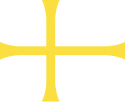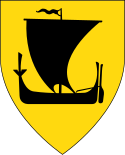Okręgi w Norwegii
| NorwegiaTen artykuł jest częścią serii: Ustrój i polityka Norwegii Ustrój polityczny Konstytucja Władza ustawodawcza Monarcha Władza wykonawcza Władza sądownicza Kontrola państwowa Finanse Samorząd terytorialny Partie polityczne Polityka zagraniczna Wikiprojekt Polityka |
Okręg (norw. fylke) – jednostka podziału administracyjnego najwyższego szczebla w Norwegii. Od 1 stycznia 2020 Norwegia podzielona jest na 11 okręgów, które dzielą się na gminy (norw. kommune)[1][2].
W połączonym królestwie Danii i Norwegii terytorium Norwegii podzielone było na dziewięć prowincji (norw. lan). W 1662 prowincje zostały zastąpione powiatami (norw. amt)[1][2].
W 1918 roku dwadzieścia, istniejących od 1866, powiatów przemianowano na okręgi[1]. W 1972 okręg Bergen został włączony do okręgu Hordaland[2]. W wyniku reformy administracyjnej z 2017 roku liczba okręgów została zredukowana do jedenastu[3].
Numeracja okręgów
Kody jednostek administracyjnych Norwegii wg standardu ISO 3166 Międzynarodowej Organizacji Normalizacyjnej składają się z kodu państwa oraz dwóch cyfr. Dotąd nie przypisywano kodów zniesionych jednostek nowo utworzonym[4].
Lista okręgów
Lista okręgów w podziale administracyjnym Norwegii po 1 stycznia 2020[2].
| Kod | Okręg | Stolica | Ludność[5] (2021) | Powierzchnia [km²] |
|---|---|---|---|---|
| 03 | Oslo | 697 010 | 454,12 | |
| 11 | Stavanger | 482 645 | 9377,10 | |
| 15 | Molde | 265 544 | 14 355,62 | |
| 18 | Bodø | 240 345 | 38 154,62 | |
| 30 | Oslo, Drammen, Sarpsborg | 1 252 384 | 24 592,59 | |
| 34 | Hamar, Lillehammer | 370 603 | 52 072,44 | |
| 38 | Skien | 421 882 | 17 465,92 | |
| 42 | Kristiansand, Arendal | 308 843 | 16 434,12 | |
| 46 | Bergen, Leikanger | 638 821 | 33 870,99 | |
| 50 | Steinkjer, Trondheim | 471 124 | 42 201,59 | |
| 54 | Troms og Finnmark | Tromsø, Vadsø | 242 168 | 74 829,68 |
Dawne okręgi
Lista okręgów zniesionych w wyniku zmian w podziale administracyjnym Norwegii po 1918[2].
| Kod | Okręg | Stolica | Ludność (rok zniesienia) | Powierzchnia [km²] | Rok zniesienia | Uwagi |
|---|---|---|---|---|---|---|
| 01 | Sarpsborg | 248 200 | 4 182 | 2020 | Włączony do nowo utworzonego okręgu Viken | |
| 02 | Oslo | 467 000 | 4 918 | 2020 | Włączony do nowo utworzonego okręgu Viken | |
| 04 | Hamar | 187 100 | 27 397 | 2020 | Włączony do nowo utworzonego okręgu Innlandet | |
| 05 | Lillehammer | 182 700 | 25 192 | 2020 | Włączony do nowo utworzonego okręgu Innlandet | |
| 06 | Drammen | 236 800 | 14 910 | 2020 | Włączony do nowo utworzonego okręgu Viken | |
| 07 | Tønsberg | 212 800 | 2 224 | 2020 | Włączony do nowo utworzonego okręgu Vertfold og Telemark | |
| 08 | Skien | 165 000 | 15 299 | 2020 | Włączony do nowo utworzonego okręgu Vestfold og Telemark | |
| 09 | Arendal | 102 200 | 9 157 | 2020 | Włączony do nowo utworzonego okręgu Agder | |
| 10 | Kristiansand | 155 700 | 7 276 | 2020 | Włączony do nowo utworzonego okręgu Agder | |
| 12 | Bergen | 435 200 | 15 460 | 2020 | Włączony do nowo utworzonego okręgu Vestland | |
| 13 | Bergen | Bergen | — | — | 1972 | Włączony do okręgu Hordaland |
| 14 | Leikanger | 107 600 | 18 623 | 2020 | Włączony do nowo utworzonego okręgu Vestland | |
| 16 | Trondheim | 320 884 | 18 848[6] | 2018 | Włączony do nowo utworzonego okręgu Trøndelag | |
| 17 | Steinkjer | 137 858 | 22 412[7] | 2018 | Włączony do nowo utworzonego okręgu Trøndelag | |
| 19 | Tromsø | 151 200 | 25 877 | 2020 | Włączony do nowo utworzonego okręgu Troms og Finnmark | |
| 20 | Vadsø | 74 000 | 48 618 | 2020 | Włączony do nowo utworzonego okręgu Troms og Finnmark |
Przypisy
- ↑ a b c Podział administracyjny. Władza lokalna, [w:] Marian Grzybowski, Norwegia: zarys systemu ustrojowego, Kraków: Wydawnictwo Uniwersytetu Jagiellońskiego, 2015, ISBN 978-83-233-3965-6.
- ↑ a b c d e Fylke, [w:] Store Norske leksikon [online], 5 marca 2021 [dostęp 2022-03-08] (norw. bokmål).
- ↑ Lene Granli, 19 fylker blir til 11 – dette skal de hete, NRK, 6 kwietnia 2018 [dostęp 2020-01-10] (norw. bokmål).
- ↑ ISO 3166 — Codes for the representation of names of countries and their subdivisions. Norway (ang.). ISO. [dostęp 2022-03-08].
- ↑ Population and land area in urban settlements, SSB, 26 października 2021 [dostęp 2022-03-08] (ang.).
- ↑ Sør-Trøndelag, [w:] Store Norske leksikon [online], 5 marca 2021 [dostęp 2022-03-08] (norw. bokmål).
- ↑ Nord-Trøndelag, [w:] Store Norske leksikon [online], 5 marca 2021 [dostęp 2022-03-08] (norw. bokmål).
Media użyte na tej stronie
Autor:
Hallvard Trætteberg, vectorization by VulpesVulpes42
The flag of the former county of Vestfold, Norway. Its design is shared with the county arms, and shows a mediaeval style royal crown, representing Vestfold's special connection to Norway's oldest royal dynasty. Harald Fairhair, from which Norwegian kings in the following centuries claimed to have descended, belonged to the Yngling dynasty, which ruled Vestfold when it was its own kingdom in the 9th century. The flag was approved by royal resolution 1970‐01‐30.
The flag of the former county of Hordaland, Norway. Its design is shared with the county arms, and consists of a crown above two crossed axes. This motif originates from a seal, that of the guild of Saint Olaf at Onarheim, which was used on behalf of Sunnhordland district on a royal letter of proclamation from 1344. The axe is the aforesaid saint's instrument of martyrdom. While it is unknown what tinctures the arms would have had in the Middle Ages, the red and gold of the modern resurrection harmonize with the national arms.
As early as in 1918, the question of county arms had been considered by the county council—nothing initially came out of this, and it would last until 1949 before the council decided that Hordaland had to get arms of its own. Getting the design approved by the Norwegian government would however prove to be a drawn‐out process lasting 12 years. Medieval coinage would feature one or two axes as a royal emblem, and as such, the National Archives entertained the idea of reserving the Onarheim seal as secondary national arms. This ultimately led nowhere, and so, on December 1st, 1961, arms based upon the old seal and a corresponding flag were finally approved for Hordaland by royal resolution.
Coat of arms for the municipality of Oslo (kommune), Norway. The Latin inscription UNANIMITER ET CONSTANTER reads: UNANIMOUSLY AND CONSTANTLY
Autor: PNG flag by AlexR.L. (CC-BY-SA 3.0)
Coat of arms by Havarhen (PD-Norwegian CoA)
SVG flag by SiBr4, Licencja: CC BY-SA 3.0
Flag of Troms County, Norway.
Flag of Aust-Agder
The flag of the former county of Oppland, Norway. Its design is shared with the county arms, and shows a spring pasqueflower. This distinctive plant is prevalent in the mountainous parts of Oppland, a county with 80% of its area situated above 600 m.a.s.l. The lush, lower‐lying parts of the county are included by the green background. Oppland's traditional districts are represented by the different parts of the plant: the two flowers stand for the Valdres and Gudbrand valleys, while the three leaves stand for the lowland districts of Land, Hadeland, and Toten. The flag was decided upon by the county council 1989‐03‐13, and approved by royal resolution 1989‐06‐23.
Independent coat of arms of Troms and Finnmark
Autor: PNG flag by AlexR.L. (CC-BY-SA 3.0)
Coat of arms by SKvalen (PD-Norwegian CoA)
SVG flag by SiBr4, Licencja: CC BY-SA 3.0
Flag of Nord-Trøndelag County, Norway.
Vestfold og Telemarks fylkesvåpen vedtatt av fellesnemnda for Vestfold og Telemark fylkeskommune den 17. desember 2018 Klåstadskipet og akantus, gull på rødt.
Autor:
Hallvard Trætteberg, vectorization by VulpesVulpes42
⸻
(Authorship information for the oldest file version:)
Coat of arms by SKvalen (PD-Norwegian CoA)
SVG flag by SiBr4, Licencja: CC BY-SA 3.0
The flag of the former county of Buskerud, Norway. Its design is shared with the county arms, and shows a blue bear, constituting an expression of Buskerud's vast expanses of mountains and forests, among which Vassfaret in particular has been known for its populations of bears. The ursine's striking colouration is a reference to the Blue Colour Works in Modum, where cobalt ore was mined, and blue pigment produced from it. For a time, the works were the largest of their kind in the world—the fruits therefrom once made up 80% of the global market, and constituted a pertinent export.
The white background of the flag carries symbolism too. Within heraldry, it is permissible to use white to depict silver, and on flags, this is even customary. Here, a white/silver background is used to represent the Kongsberg Silver Mines, and their massive mineral riches—operating between 1623 and 1957, their history spanned over 300 years. The flag was approved by royal resolution 1966‐04‐01.
Møre og Romsdal sitt fylkesvåpen. Visar tre gule vikingskip sett forfrå på blå bakgrunn.
Autor:
Hallvard Trætteberg, vectorization by VulpesVulpes42
⸻
(Authorship information for the oldest file version:)
Coat of arms by SKvalen (PD-Norwegian CoA)
SVG flag by SiBr4, Licencja: CC BY-SA 3.0
The flag of the former county of Østfold, Norway. Its design is shared with the county arms, and shows a sunbeam, which makes two different links symbolically. Firstly, as the sun rises in the east, it refers to the name and geographic location of the county ("øst" means east in Norwegian). Secondly, the solar design alludes to the fertility worship expressed in the numerous Bronze Age petroglyphs found in Østfold. In heraldry, the rays of the sun are often depicted as alternatingly straight and wavy, with the straight rays being said to represent light, and the wavy ones heat. The flag was approved by royal resolution 1958‐09‐26.
Fylkesvåpen for Viken fylkeskommune
Coat of arms for Trøndelag county (fylke), Norway. Until 1 January 2018 coat of arms of Nord-Trøndelag (county), Norway.
Autor: PNG flag by AlexR.L. (CC-BY-SA 3.0)
Coat of arms by SKvalen (PD-Norwegian CoA)
SVG flag by SiBr4, Licencja: CC BY-SA 3.0
Flag of Sør-Trøndelag County, Norway.
Coat of arms for Vestland county, Norway
Autor:
Truls Nygaard, vectorization by VulpesVulpes42
⸻
(Authorship information for the oldest file version:)
Coat of arms by SKvalen (PD-Norwegian CoA)
SVG flag by SiBr4, Licencja: CC BY-SA 3.0
The flag of the former county of Hedmark, Norway. Its design is shared with the county arms, and shows three bark spuds. An innovative heraldic charge, it is well suited to represent forestry, befitting Hedmark's status as Norway's largest forest county. The triad of spuds can addedly stand for the three traditional regions of Østerdalen, Solør‐Odal, and Hedmarken. The flag was decided upon by the county executive board 1986‐12‐16, and approved by royal resolution 1987‐02‐06.
Autor: Finn Fagerli, vectorization by Gunnar Offel, Licencja: CC BY-SA 3.0
The flag of the former county of Akershus, Norway. Its design is shared with the county arms, and shows a stepped gable, suggestive of the silhouette of Akershus Castle. It is from this fortress that the county as a geographical area (as well as several historical administrative entities in Norway) gets its name. By extension, the motif alludes to the centuries‐old connection between the castle and its environing districts. The flag was decided upon by the county executive board 1987‐05‐05, and approved by royal resolution 1987‐12‐11.
Coat of arms for Nordland county (fylke), Norway.
Coat of arms for Rogaland county (fylke), Norway.
Agder fylkesvåpen
Flag of Sogn og Fjordane, Norway.
Autor: PNG flag by AlexR.L. (CC-BY-SA 3.0)
Coat of arms by SKvalen (PD-Norwegian CoA)
SVG flag by SiBr4, Licencja: CC BY-SA 3.0
Flag of Telemark County, Norway.
Coat of arms for Innlandet county (fylke), Norway.
Kommune- og regionreform: "Stortinget vedtok 8. juni 2017 følgende sammenslåinger av fylker". Medfølgende kart-illustrasjon.































